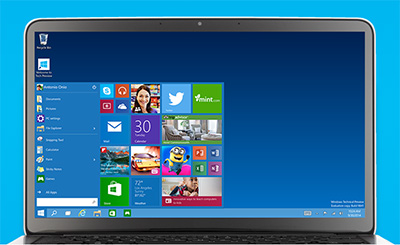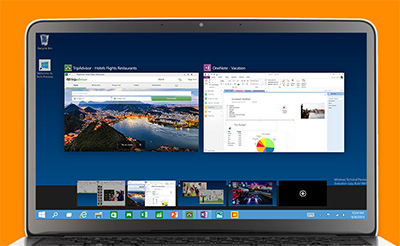News
Windows 10: What We Know So Far
More on This Topic:
Microsoft plans to tell us what we don't know about Windows 10 in a Wednesday January 21 event, namely, the consumer side of the new operating system.
Many think of Windows 10, currently at the preview stage, as Microsoft's attempt to make good with its business customers. They may have become alienated by the mobile-centric and touch-based user interface of Windows 8. The idea that Windows 10 will address those business concerns comes from Microsoft itself. For instance, at Windows 10's San Francisco unveiling in September, Terry Myerson, Microsoft's executive vice president of Operating Systems, stressed that businesses would be familiar with the Windows 10 interface and that Windows 10 would be compatible with traditional management systems.
The January 21 event is expected to disclose details about a new "consumer version" of Windows 10. This idea that it will be a new version of the OS designed for consumers (rather than just another "edition" of Windows) comes from a description by long-time Microsoft watcher Mary Jo Foley. Microsoft, though, hasn't been so explicit.
Foley offered speculation about what the consumer features of Windows 10 will be. Her sources told her that there will be a second browser, code-named "Spartan," that will run alongside the traditional Internet Explorer 11 browser in Windows 10. She also speculated that Microsoft will integrate its Cortana personal assistant app into Window 10. In addition, Microsoft likely will play up its "continuum" Windows 10 feature at the event. The continuum feature changes the behavior of the OS somewhat for machines that can convert from keyboard-based laptops to touch-based tablets. Microsoft shows how this continuum feature works in this YouTube video.
Windows 10 Mobile?
Microsoft is on the record as saying that it intends to replace its Windows Phone OS with Windows 10 sometime in the near future. It's possible that that the January 21 event could include some mobile device talk along those lines. Whether Windows 10 will be an easy port for end users from Windows Phone 8.1, or other versions of the Windows Phone OS, remains to be seen. We could also get some talk about Windows 10 for ARM devices as Microsoft has remained somewhat mute about support for that other platform. Consumers are already seeing lower-cost Windows 8.1 tablets on the market using Intel's x86 chips, and there may be more to tell there, too, in terms of Window 10.
Putting Windows 10 on smartphone devices is just part of the larger story, though. Microsoft has been trying to enable a so-called "universal app platform" with Windows 10. This platform supposedly will make life easier for developers. They can code once for apps that will run across various Windows 10 devices, regardless of form factor or device size. The implications for consumers might be that Windows 10 apps purchased for a Windows Phone might also be capable of running on a Windows 10-based tablet or PC, giving consumers some added flexibility. It might offer a reason to gravitate toward the Windows 10 platform, rather than Android or iOS.
Update: Foley reported on Tuesday that a first release of a new Windows 10 mobile OS won't happen until next month, based on her sources. She said she expects to see multiple Windows 10 OS products coming from Microsoft that will be based on device type and screen size. Microsoft may show off its touch-based Office version at the event and a new gaming helmet. The talk will center on Microsoft's "OneCore" OS approach, she stated.
Microsoft has already announced its intention to unify its app store experience to support these universal apps. However, much of its discussions about this new Windows Store for Windows 10 has centered on the perks for organizations, rather than for consumers, including some new management capabilities. Possibly, some of the new Windows Store capabilities described as beneficial for organizations, such as automated patching of applications, will also be available for consumers. It is semi-rumored that the new Windows Store for Windows 10 will house older "desktop" apps, such as Windows 7 apps, in addition to its current stable of Windows Store apps (also known as "Metro" or "Modern" apps). Microsoft will let organizations create a "curated" cluster of their business apps in the Windows Store. Possibly, Microsoft could extend that capability to consumers.
Microsoft's overall messaging to organizations has been about enabling bring-your-own-device (BYOD) to work scenarios through a Windows 10 container technology. The container technology will allow a user's business apps and data to be separately managed from personal apps and data. Microsoft may want to tell that story to consumers in its January 21 event, too, although enabling BYOD scenarios depends on an organization having the latest Microsoft server technologies, as well as its Enterprise Mobility Suite licensing, in place. Explaining that sort of message to consumers, though, might be too much.
Consumer Features
Likely, the consumer view of Windows 10 on January 21 will rehash the user interface features that are already known. For instance, an improved start menu currently exists in the Windows 10 preview that includes a Windows 7-like menu with live tiles. It's part of Microsoft's redesign aimed at making things more familiar for keyboard and mouse users. Microsoft's Twitter feed for Windows 10, #Windows10, included the following image as a teaser:
 [Click on image for larger view.]
Start Menu for Windows 10. Source: Microsoft.
[Click on image for larger view.]
Start Menu for Windows 10. Source: Microsoft.
Microsoft can be expected to talk about its "task view" feature in Windows 10, which lets users set up different desktop views. As if to highlight that notion, Microsoft posted this image on its Twitter feed with the caption, "separate work and play with multiple desktops on a single device":
 [Click on image for larger view.]
Task View for Windows 10. Source: Microsoft.
[Click on image for larger view.]
Task View for Windows 10. Source: Microsoft.
Other known Windows 10 OS features include the ability to run Windows Store Apps in sizeable and moveable windows. An improved "snap" capability that can combine Windows Store Apps with "desktop" (Windows 7-style) apps, with up to four apps viewable per screen, may also get described. More speculative is whether Microsoft will retain the current dual desktop/Windows Store App user interface, or unify it.
Possibly, we'll also get some surprises during the January 21 events. For instance, a rumor was floated that "Windows 9" (which Microsoft skipped for Windows 10) would be a free upgrade for some Windows users. The idea of a free Windows 10 upgrade remains a popular notion. The argument is that Microsoft could bulk up its OS market share since Windows 8 didn't light the world on fire. In addition, there's already a precedent of sorts as Microsoft offers its Windows Phone 8.1 OS to some OEMs royalty free. A free Windows 10 idea was perhaps suggested in a talk by Kevin Turner, Microsoft's chief operating officer. Turner, in describing Windows 10, said that Microsoft was prepared to monetize the OS in a new way by selling added services.
The January 21 press event will include top Microsoft executives such as Myerson, Corporate Vice president for Operating Systems Joe Belfiore, and CEO Satya Nadella, among others. A live public Webcast of the event will be streamed at 9:00 a.m. Pacific Time. It can be accessed at this page.
Microsoft is slated to release another build of its Windows 10 preview sometime this month. It's not clear exactly when, though. Microsoft has said that Windows 10 will be rolled out as a product in the latter part of this year.
About the Author
Kurt Mackie is senior news producer for 1105 Media's Converge360 group.